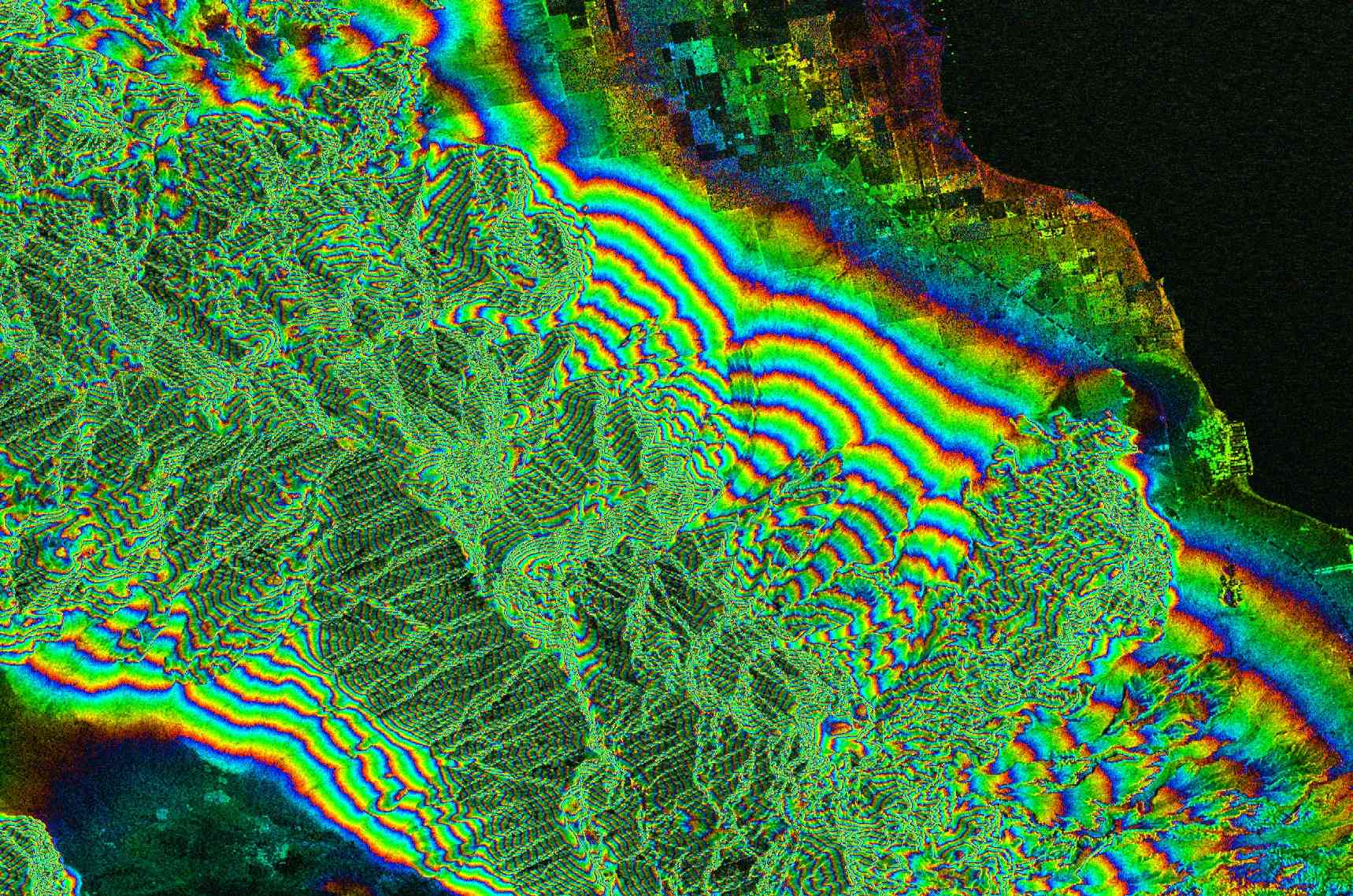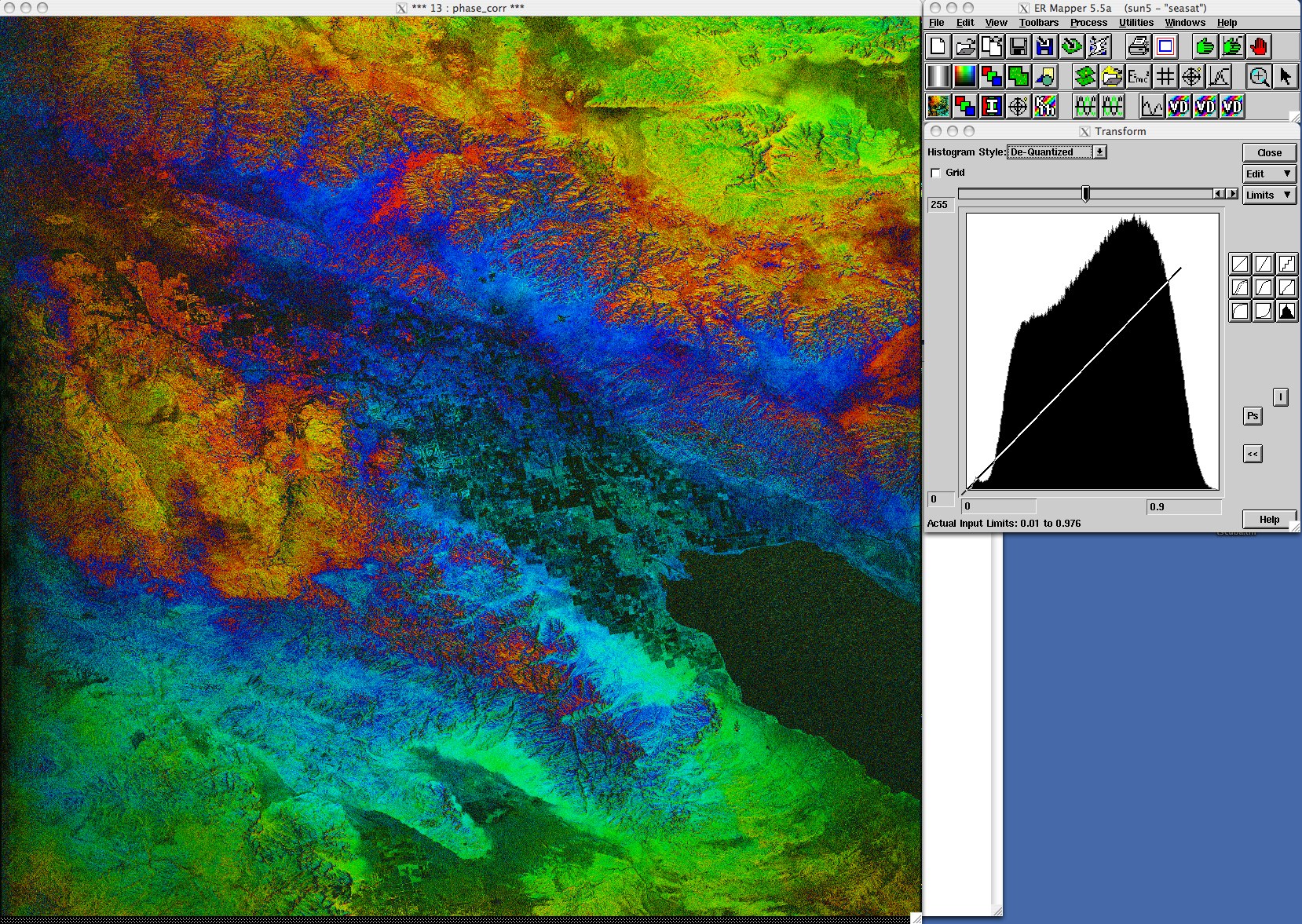ALOS Interferometry - David Sandwell and Meng Wei -
August 18, 2006
1) What is ALOS?
2) Why is L-Band better than C-band?
3) Is
PALSAR interferometry possible?
4) Where can I
find new results?
5) Where can I
get a sample L1.0 data set? Level
1.0 Documentation?
6) What
else is special about PALSAR?
7) What
is the current coverage along the San Andreas Fault?
8) What
is the data acquisition plan for North America?
9) How
and when can I get more data? What about precise orbits?
10)
What special software will be needed?
11) Software developments at SIO?
Send an
e-mail if you have other questions.
3) Is PALSAR interferometry possible? YES
As part of our calibration and validation
effort with JAXA, they delivered an interferometric pair over the
Southern San Andreas fault area. This pair is from a
descending pass in fine beam standard, 34.3 look angle collected on
June 8 and July 24.
This is the first and only interferogram that we attempted and it seems
to have better coherence and have higher resolution than a typical ERS
scene. The phase (superimposed
on amplitude of interferogram) and a zoom
of the phase show promising results
although there is an additional software improvement required to
account for the 1060-m baseline for this pair. The details of the
reference and repeat parameter
files provide the necessary SAR and InSAR processing parameters. To do:
- Because
the range resolution of PALSAR is about 2 times better than ERS and
Envisat, the alignment of the reference and repeat images in the range
direction must be about two times more precise. This coupled with
the much longer baseline causes a small elevation-depenent range shift
that must be corrected (now corrected in this image). The improvement in correlation is seen
in this image where correlation is improved at the highest
elevations of Toro Peak at 2700 m (left - no topographic shift, right -
topographic shift). The residual
range shift from the 6-parameter image matching is in accordance
with the residual shift based on topography and baseline information
demonstrating that correction for this effect is accurate.
- Need to
optimize the width of the Gaussian multi-look filter that is applied to
the full resolution interferogram.
- Need to
apply topographic phase correction from SRTM topography. This has
now been done. The residual phase
(superimposed on correlation) has only 1 N-S fringe (12 cm) along the
scene. There was NO flattening done on this scene so the residual
phase could be due to orbit error, atmospheric delay or perhaps a bug
in the ellipsoidal correction part of the code. The histogram of the correlation associated with
this residual phase shows very high correlation especially in areas
that are radar bright.
6) What else is special about PALSAR?
- The length
of the synthetic aperture for PALSAR is ~6000 lines while it is only
~1200 lines for ERS. Therefore, in order to obtain proper focus,
the Doppler frequency rate must be accurately estimated from the
precise orbit (see below).
- The
near-range changes along the track similar to ERS.
- The yaw
steering seems to be very accurate. All 6 of our example data
sets have Doppler centroids < +/- 100 Hz.
- For the
Fine Beam Single (FBS) polarization mode, the bandwidth is 28 MHz or
about twice ERS. Therefore the typical raw data file has a line
length
of ~10000. This coupled with the increased aperture length
means you'll need about 6 times more memory for efficient SAR
processing.
- PRF
changes along the track between 1800 and 2200. Every SAR
images that we have processed so far has a different PRF except for the
interferometry which fortunately shares a common PRF. Be ready to
write a PRF interpolator.
7)
What is the current coverage along the San Andreas Fault?
This depends a lot on the location. I did two 1-degree searches
of FBS data only for the time period June 1, 2006 to August 11,
2006. The San Francisco area has only 3
scenes while the Pinon area has 40
scenes. The higher number at Pinon is because they make every
acquisition over the calibration/validation sites.
8) What is the data acquisition plan for North
America?
9) How and when can I get more data?
What about precise orbits?
- Precise
orbits accurate to < 1 m are delivered with the L1.0 product in the
leader file as 28 state vectors. They are available 3 days after
data acquisition. This was accomplished with our first data order.
- The
calibration/validation phase extends from 1/2006 until 11/1/2006.
Cal/Val members get 50 scenes free.
- The WInSAR
investigation begins ~11/1/2006 and WInSAR will be given 50/scenes
per
year. Yes, the original proposal had ~600 scenes/year but JAXA, at the request of the data nodes,
re-negotiated all the investigator contracts to limit the distribution
to 50/yr. JAXA also removed all the WInSAR CI's. If
you would like to share these 50 scenes, please send me an e-mail and
I'll write a letter to JAXA asking for you to be included as a
CI.
- GeoEarthScope
may have additional funds to purchase data.
10) What special software will be needed?
- Better
estimates of the Doppler frequency rate derived from the precise
orbit. The precise orbit is stored in the LED-file as 28
state vectors of position and velocity spaced at 60s intervals. A
hermite polynomial interpolator is needed to interpolate to the echo
points in the 16-s frame.
- An
image-matching algorithm to account for the parameter corresponding
to the change in range shift along the azimuth direction due to
the 22-m of convergence we found in our interferometry pair. (Already
implemented in ROI_PAC.)
- An
image-matching algorithm to account for the
topographically-dependent range shift. This is basically a
stereoscopic effect that has become important because of three major
changes between ERS and ALOS: 1) 2x better range
resolution; 2) 8x increased critical baseline; and 3) 3300m elevation
change
in
our test area. Our example interferometric pair has a horizontal
baseline of 1000 m so the range shift due to an elevation change is ~3
m or .7 pixels which is large enough to cause decorrelation in the
interferogram. We are working on the algorithm and will
update this page.
11)
Software developments at SIO? We maintain
5 modules to do
the basic InSAR processing (SIOSAR). These include:
- pre_proc_alos = alos_line_fixer + alos_ld_read + dopiq - This is ALL NEW software.
- sarp - The standalone SAR
processing with 5-parameter image matching needed minor changes for
ALOS.
- offset/fitoffset - no changes
- synth - new llt2rat program to map lon, lat,
topo into range azimuth topo using the precise orbit.
- pdiff- changed to include
topographically-dependent image alignment correction

